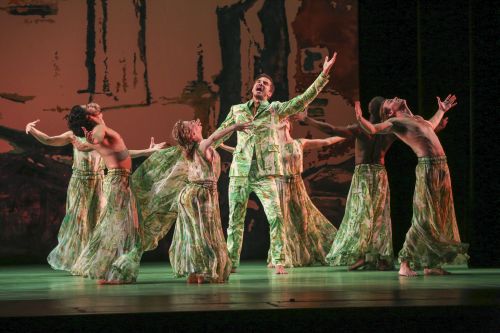 United States Mostly Mozart (4):Handel, Acis and Galatea (arr. by Mozart): Mark Morris Dance Group, Mark Morris (Director and Choreographer), Philharmonia Baroque Orchestra and Chorale, Nicholas McGegan (Conductor), David H. Koch Theater, Lincoln Center, New York, 7.8.2014 (SSM)
United States Mostly Mozart (4):Handel, Acis and Galatea (arr. by Mozart): Mark Morris Dance Group, Mark Morris (Director and Choreographer), Philharmonia Baroque Orchestra and Chorale, Nicholas McGegan (Conductor), David H. Koch Theater, Lincoln Center, New York, 7.8.2014 (SSM)

Cast:
Yulia Van Doren: Galatea
Thomas Cooley: Acis
Isaiah Bell: Damon
Douglas Williams: Polyphemus
Production:
Adrianne Lobel: Scenic Design
Isaac Mizrahi: Costume Design
Michael Chybowski: Lighting Design
Dancers:
Chelsea Lynn Acree, Sam Black, Rita Donahue, Domingo Estrada Jr., Benjamin Freedman, Lesley Garrison, Lauren Grant, Brian Lawson, Aaron Loux, Laurel Lynch, Stacy Martorana, Dallas McMurray, Maile Okamura, Brandon Randolph, Billy Smith, Noah Vinson, Jenn Weddel, Michelle Yard
Acis and Galatea was written during Handel’s stay as composer-in-residence at Cannons, the idyllic country estate of the Duke of Chandos. The original production was barebones: three sopranos, a tenor and a bass, who also served as the chorus. The orchestra consisted of two violins, two cellos and two musicians on oboe and recorder. This allowed the entire group to perform Acis in a large room such as those available in the spacious mansion. (Many years ago a traveling troupe was able to do a full production of Acis at my daughter’s elementary school in a large classroom.)
For later productions, Handel augmented the orchestra, adding trumpets, horns and flutes. Mozart filled out the orchestra even more in his arrangement, most drastically by replacing the Baroque wind of choice, the oboe, with the recently invented keyed clarinet. So here at Lincoln Center we had a Baroque band on original instruments conducted by a Baroque specialist, Nicholas McGegen, performing an updated, non-Baroque version using Baroque instrumental and vocal techniques.
There are some gains made when using Mozart’s orchestration, including his magical transformation of secco recitatives into seamless accompagnatos. His substantive changes in orchestration allow Acis to be performed in a space as large as the Koch Theater and, at times, Mozart successfully fills out the very thin orchestral lines. But what is largely missed is the purity, clarity and intimate timbral colors of the original version. When the chorus sings Mozart’s arrangement of “Wretched lovers,” we hear the Mozart of the Masses and the Requeim, not the haunting Monteverdi-like madrigal with its meandering counterpoint from the original score. Mozart’s decision to use the keyed clarinet to replace the recorders or oboes as the obbligato instrument obviates the point of several arias.
Mark Morris choreographed a magnificent dance that clearly has been thought through and well-rehearsed. Even some of his attempts to add levity to the choreography were successful: the Pilobolus-like metamorphoses of the dancers in imitation of Polythemus’s stride when “ample strides” is sung; or the clever grouping of the dancers into a flock of sheep at the mention of flocks. Yes, there were Morris’s obvious “dancing out” lines of text: the waving of hands when a character leaves, or everyone on stage pointing in the same direction when Acis sings, “Where shall I seek the charming fair.” But this production never reaches the sophomoric lows of Morris’s version of Purcell’s “King Arthur,” where the famous aria, “Genius of the Cold,” was sung from inside a refrigerator.
The staging left something to be desired: abstract backdrops that looked at times like a forest, a snow-covered street, a city skyline or a mobile home. The costumes were simple, sheer fabric that breezed along with the dancers, almost taking on a life of their own. There was nothing in the costumes that approached the brilliance of the Morris-Mizrahi production of Rameau’s Platee, but nothing has come ̶ and may never come ̶ close to that collaboration.
In contrast to most operas with dancing, the music was subservient to the choreography. Perhaps the dominance of the dancing, which continues without stop from beginning to end, led to some degree of tepidness in the overall performance. The singers were generally stiff and inflexible, and only in the final few arias did they really seem to mesh with the dance troupe and generate a sympathetic warmth. These final moments leading to the requisite happy ending brought to mind the poignant and plaintive production of Purcell’s Dido and Aeneas with Morris himself as Dido.
The singing never did soar but there is not much soaring in the score itself. Douglas Williams had the most interesting role as the lecherous and gluttonous Polpyphemus. Thomas Cooley started off a little weakly but gained strength as the work progressed. Yulia Van Dooley sang well but seemed overwhelmed by the action going on around her. The same could be said of the chorus-like role of Michael Chybowski as Damon, the shepherd friend, who like Belinda in Purcell’s Dido tries to respond positively to the lovers’ plaints.
Conductor McGegan and his Philharmonic Baroque Orchestra, now in its 34th year, were spot on. Everything was played to perfection, with special praise due to the clarinetists and to the valveless horn players, who are always to be complimented for successful performances on their devilish instruments.
Stan Metzger
